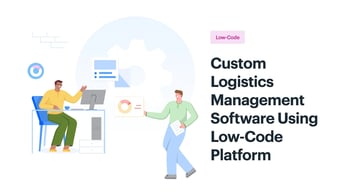It may have been off to a slow start, but the low-code revolution is now blazing across all industries. Low-code and no-code technologies are disrupting traditions and paving the way for faster digital transformation.
Regardless of your industry, joining the low-code revolution is imperative for business growth, especially in today’s digital age. If you aren’t in on the action yet, here’s a quick run-through of what low-code is and how it impacts your business.
What is the low-code revolution?
The low-code revolution is a significant and wide-reaching change in how we create software. Veering from the lengthy and complex development process, low-code simplifies app development through visual modeling and automated code generation.
Low-code empowers non-technical users, including citizen developers, to create the specific software solutions they need without using complicated codes. In business enterprises, this results in faster responses to customer needs and changing market conditions.
How does the low-code revolution help in accelerating business transformation?
The low-code revolution is transforming the way businesses approach software development. Here are some of the many ways it is driving business transformation.
1. Reduces development costs
Low-code application platform reduce the time and effort required to build and deploy software. This lowers the cost associated with development, maintenance, and support.
2. Taps into a broader creative pool
Low-code allows for more creativity. It enables non-technical staff to build applications, expanding the pool of creative talent and allowing businesses to innovate better solutions.
3. Increases productivity
Low-code reduces the time and effort required to build complex applications. This significantly improves productivity and allows you to launch new products and services faster.
4. Allows for fast and easy iterations
Through low-code, apps can be altered without difficulty. You’d be able to easily modify and update applications, which can be crucial in rapidly changing business environments.
5. Minimizes the use of external resources
With a low-code platform like Kissflow, you can build applications in-house without outsourcing software developers or IT consultants. This reduces the need for external resources and minimizes development costs.
6. Increases diversity and inclusion
By making app development more accessible to all users, low-code opens new opportunities for everyone to participate in digital transformation, increasing diversity and inclusion within your organization.
7. Empowers citizen developers
Low-code brings to the front a new generation of app builders. By empowering non-technical employees to build applications, low-code development increases the number of citizen developers within organizations.
Key steps to prepare your business for the low-code revolution
Implementing new solutions is never as easy as flipping a switch. You’d need to prepare your system and people to adopt the latest technology for your low-code transition. While each business will have unique ways to transition, here are some basic steps to spark the revolution within your organization.
1. Adopt a change management strategy
Existing company culture may hamper the transition to low-code development. People who are more familiar with traditional coding methods may resist change. To overcome this, you must adopt a change management strategy that communicates the benefits of low-code development and encourages your employees to embrace the new paradigm.
2. Provide comprehensive training
To ensure a successful shift to low-code, conduct hands-on training sessions and give access to online training resources. Make sure everyone is well-trained on how to use the low-code platform you’ll be using to ease the transition and minimize disruptions in workflows.
Ensure also that users are given hands-on experience with multiple platforms. This allows you and your employees to shift to the most appropriate platform when necessary.
3. Engage with the community
Resources at this level will be low. To stay up-to-date with the latest trends, best practices, and innovations, you must engage with the low-code development community. Connect with other organizations, attend industry events, or participate in online forums.
For help in preparing your business for the low-code revolution, Kissflow offers robust training resources and a supportive community. It also has a user-friendly interface that eases culture shock. Moreover, it integrates with other low-code platforms, allowing you to switch between platforms and maximize your investment in low-code tech.
Business and IT Can Collaborate Together
Some developers live in fear of low-code and no-code, but for the most part, those fears are baseless. Yes, there will be less development coming their way, but the notion that their jobs are irrelevant with the advent of low-code and no-code is unfounded.
There will always be a need for skilled developers. Allowing developers to spend more time on complex implementations and give the responsibility of creating long-tail applications back to the business user, that’s the change that low-code development tools bring to an organization.
This is where business and IT can collaborate together. By allowing business users to take care of simple implementations, IT can help out with complex requests that cannot be done easily through low-code and no-code.
If an application is under development, business users can focus on the simpler parts while IT can collaborate on the more complex aspects.
This kind of collaboration is where digital transformation starts taking place in an organization.
Low/No-Code Drives Innovation
Regardless of which industry you’re in, innovation is a constant need. If you’re not constantly performing better than your competitors, then you’re not going to get ahead of them.
With low-code and no-code, innovation can happen at incredible speeds. Every time a new app is created, business users think more about the possibilities and poke their own technological box out a few inches. Once business users realize what is possible, they start to get a vision of what the future can be like.
When IT professionals and business users come together to solve a common problem, even with the smallest of apps, that’s what drives innovation. Low-code and no-code enable this innovation to deliver results faster.
Low-code and No-code Can Drive IT Modernization
We’ve talked about how low-code and no-code can enable digital transformation, but little into how it actually does this.
1. Allows Scalable and Fast Deployment of Apps
Low-code solutions and no-code development platform provide a quick and easy way to deploy apps, while allowing for easy maintenance and scaling as and when required.
In organizations where the number of staff can change rapidly and needs evolve constantly, this enables your processes to be agile.
2. Makes Digital Transformation EVERYONE’S Responsibility
Digital transformation is typically seen as the IT department’s job. They have to do the work to convince and drag the rest of the company into the digital sphere.
However, by offering a no-code platform, IT can actually spread that responsibility across the entire organization. For example, it would take IT years to digitize every business process in a company and gather data from it. But, if they offer a no-code app development platform to business users, they will create their own low-code apps and do the work themselves.
3. Lower Risk
Investing in developers, training them, and integrating them into your organization is an expensive and time-consuming task. If you’re going to use them to write every single application that you need, it’ll be a risky proposition, since there are going to be some applications that will not produce the intended result, and the whole plan will be scrapped.
With low-code and no-code, even if you produce applications that ultimately are a failure, the loss of time and cost is very minimal. This kind of reduced risk lets you move forward with the confidence that can afford to fail without being reprimanded.
The battles between IT and business don’t have to go on. It can shift to a collaboration where each one riffs on beats provided by the other.
When business and IT can work in synergy with each other, the end result is an organization that can be more productive than each department could be alone. That’s where low-code and no-code come in to save the day. Instead of having both departments being at loggerheads with each other, business and IT can work together, enabling everyone in the organization to grow and work together.
Accelerate business transformation with the best low-code platform
To meet your needs for speeding up your transformation, you must implement the best low-code platform that provides the specific solutions you need. Kissflow, the leading low-code platform today, is an innovative solution that gives you the power to embrace low-code development easily.
Sign up for a free trial today to see how Kissflow amps your arsenal of tools for digital transformation. Be well-equipped as you join the low-code revolution.












